Viburnum species are woody shrubs with clusters of blossoms in shades of cream, white, or pink. They flower from late winter into spring, or spring into summer.
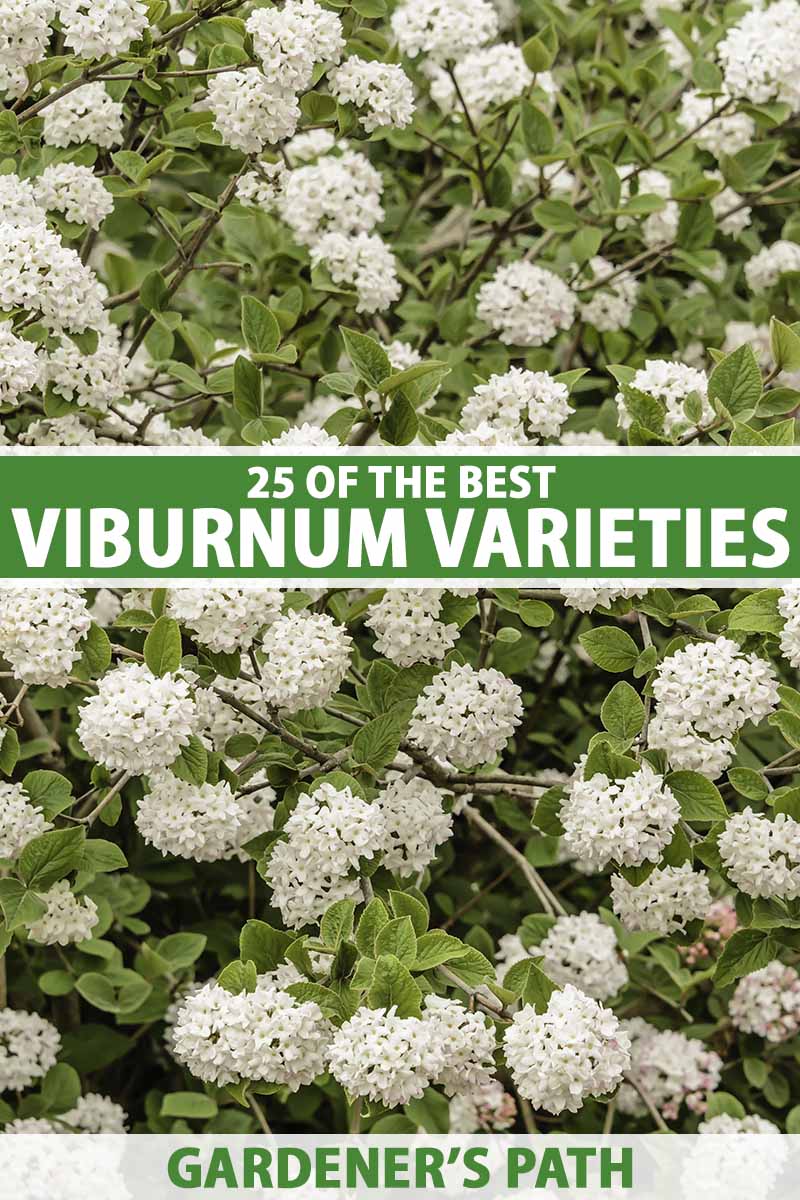
We link to vendors to help you find relevant products. If you buy from one of our links, we may earn a commission.
In late summer to fall, the robust, deeply veined green foliage of many deciduous types deepens to rich red, burgundy, orange, and yellow hues. Colorful berry-like drupes stand out strikingly in shades of pink and red, orange, blue, blue-black, and black.
At season’s end, any drupes the birds haven’t eaten add to the winter interest provided by bare branches that stand out starkly against a backdrop of winter snow.
There are many types of viburnums, with mature heights of two to 30 feet and widths of two to 15 feet. The best time to plant is in the spring or fall.
In this article, you’ll find 25 of the best viburnum shrubs to add to your outdoor space and the highlights of each.
Here they are:
25 of the Best Viburnum Varieties
Not all viburnums produce a vigorous drupe display. There are sterile, non-fruiting shrubs and those that set scant quantities.
If you grow fruiting varieties that produce drupes, you’ll need to choose two genetically different species or cultivated varieties that bloom simultaneously, and plant them at a distance of no more than 50 feet apart to support cross-pollination.
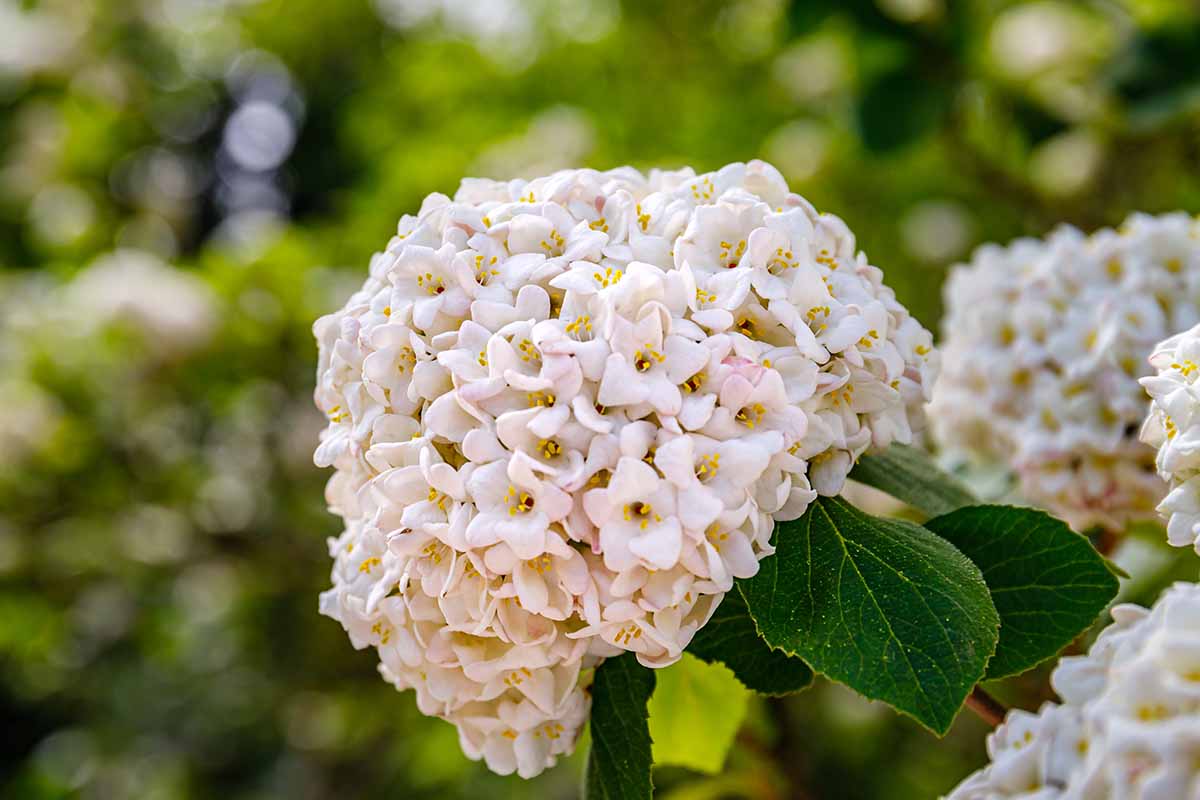
Note that not all viburnums have a spicy-sweet fragrance. It is more common for the flowers, foliage, and even the wood to have a musky odor, or no odor. Fragrant varieties are noted below.
A number of non-native Viburnum species are considered invasive in some Midwestern states, including V. dilatatum, V. lantana, V. opulus, V. plicatum f. tomentosum, V. setigerum, V. sieboldii, and V. tinus, so you may wish to avoid these.
And finally, note that viburnum grows best in full sun to part shade. If summer temperatures reach 90°F in your area, afternoon shade is beneficial.
And now, let’s meet our favorites!
1. Allegheny
V. x rhytidophylloides ‘Allegheny’ is a hybrid cultivar that has fragrant white blossoms with raised yellow anthers for a fuzzy look. It grows in Zones 5 to 8.
Called a “leatherleaf” variety, the foliage is deeply creased with veins for a textured, leather-like appearance.
Bright red drupes mature to black. Height and width maxes out at eight to 10 feet.
‘Allegheny’ is available from Nature Hills Nursery.
2. American Cranberrybush
American cranberrybush, V. opulus var. americanum, (formerly V. trilobum) is known best for its edible red drupes.
It’s a native shrub for Zones 2 to 7 that grows to mature dimensions of eight to 12 feet tall and wide.
The flowers are snow white. Deciduous leaves turn burgundy, orange, scarlet, and yellow before dropping in the fall.
Wet soil is no problem as this species grows in bogs in the wild.
American cranberrybush is available from Nature Hills Nursery.
3. American Spice
American Spice™, V. x burkwoodii ‘Duvone,’ was a surprise “sport” of hybrid cultivar V. x burkwoodii ‘Sarcoxie.’
It is more compact and fragrant than ‘Sarcoxie,’ and it keeps its leaves longer.
This cultivar is suitable for growing in Zones 5 to 9.
The flowers are pink in the bud stage and open to reveal white blooms with a delightful clove-like scent.
In the warmest regions, the leaves may remain evergreen. Elsewhere, fall foliage is a rainbow of reds, yellows, and oranges well into winter. Red berries deepen to black.
Expect a mature height of four to five feet with an equal spread.
American Spice™ is available from Nature Hills Nursery.
4. Arrowwood
Native arrowwood, V. dentatum, has a history of use by Indigenous Americans to make straight and sturdy arrows.
It’s suited to cultivation in Zones 2 to 8 where it matures to dimensions of six to 15 feet tall and wide.
Creamy white blossoms adorn the branches of V. dentatum in springtime. Bluish-black drupes nestle among the multicolored fall foliage.
These plants are tolerant of clay soil.
Three- to four-feet bare roots are available from Nature Hills Nursery.
5. Brandywine
Suited to Zones 5 to 9, Brandywine ™ viburnum, (aka V. nudum ‘Bulk’) is a cultivated variety of the native species V. nudum, commonly referred to as possumhaw viburnum or smooth witherod.
Instead of growing five to 12 feet tall like the species plant, it achieves a compact height and width of five to six feet max.
Fragrant, flat blossoms are white with elongated yellow anthers for a fuzzy look.
Autumn foliage may blaze red and deep purple. Richly hued pink and blue drupes accent the spectacular display.
This cultivar has a high tolerance for wet soils.
Brandywine™ plants are available from Nature Hills in #3 containers.
6. Burkwood
Burkwood, V. x burkwoodii, is a hybrid suited to Zones 5 to 8.
A cross between V. carlesii and V. utile, Burkwood viburnum is named after nurserymen Arthur and Albert Burkwood, who were responsible for the hybridization in 1924.
Unlike many white varieties, the blossoms do not have elongated anthers and a fuzzy appearance. Instead, they are tubular, white, and almost wax-like.
Leaves bronze to reds and purples in the fall and are accompanied by red drupes ripening to black.
Expect a mature height of six to eight feet and width of five to seven feet.
Burkwood is available in #5 containers from Nature Hills Nursery.
7. Cayuga
Fragrant hybrid cultivar V. x carlcephalum ‘Cayuga’ has pink buds that gradually shade to tubular white blossoms. It’s best suited to Zones 5 to 8.
In the fall, the green, leather-like foliage is a deep purple. Sparse red berries highlight the autumn display.
Expect mature dimensions of four to eight feet tall and six to eight feet wide.
Cayuga is available from Nature Hills in #3 containers.
8. David
David, V. davidii, is a low-profile sweetheart with a mature height of only two to three feet and width of three to four feet. It does best in Zones 7 to 9.
The blossoms start as pink buds and open to reveal white blooms in an arrangement of flat-topped clusters.
In Zone 9, the leathery, blue-green leaves are evergreen. In Zones 7 and 8, expect them to deepen to a rich burgundy. Pink drupes shade to red before turning a striking turquoise-blue.
The modest proportions of this species make it well-suited to container gardening.
David is available in #2 containers from Nature Hills Nursery.
9. Dawn
V. x bodnantense ‘Dawn’ is a cultivar of the Bodnant viburnum, a hybrid cross between V. farreri, a fragrant Chinese species, and V. grandiflorum, a fragrant Himalayan species.
It is prized for having clusters of sweetly-scented pink blossoms that shade light and dark for depth and visual appeal, and is suited to cultivation in Zones 5 to 8.
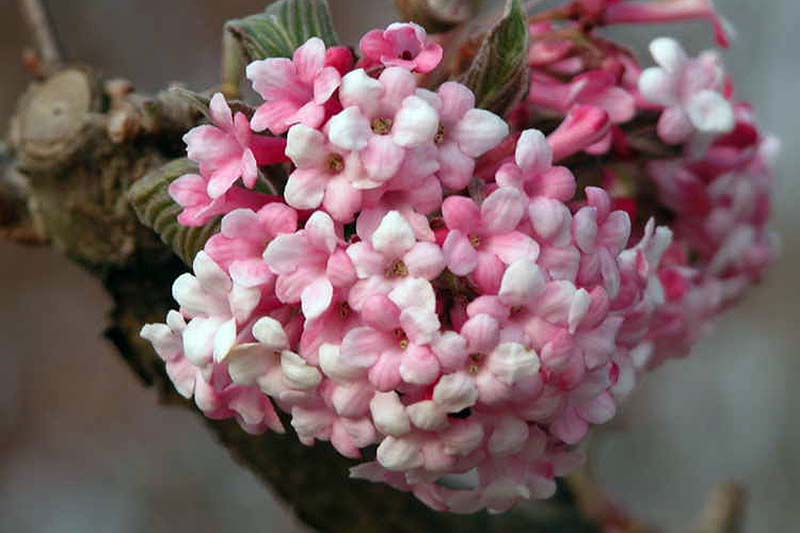
This cultivar reaches a mature height of eight to 10 feet and spreads four to six feet wide.
A characteristic to note is that in the warmest regions, flowers bloom from fall to spring on leafless cinnamon-colored stems.
Emergent green foliage has red stems.
Fall foliage shades to red and burgundy with red drupes that deepen to black.
10. Emerald Triumph
V. x ‘Emerald Triumph’ is a hybrid cross of V. x rhytidophylloides ‘Allegheny’ and V. burejaeticum, or Manchurian viburnum, a white-flowered Chinese species.
Clusters of white blossoms have a fuzzy appearance created by long stamens with yellow anthers.
The leaves are leather-like and blue-green. In the warmest locations within their range, they remain green.
In cooler climes, deep red leaves and red drupes that darken to black spark fall-to-winter interest.
Mature plants are six to eight feet tall and wide, and they can tolerate clay soil.
‘Emerald Triumph’ is available from Nature Hills Nursery.
11. European Snowball
European snowball, V. opulus ‘Roseum’ has a tree-like growth habit and does well in Zones 3 to 8.
V. opulus, aka the European cranberrybush is considered invasive in parts of the US, but this is a sterile cultivar that produces no berries.
It has green flowers that mature to white and fade to pink. They are arranged in round clusters and resemble those of a mophead hydrangea.
The leaves turn red and orange in the fall.
Expect mature heights and widths of 10 to 12 feet.
European snowball is available from Nature Hills.
12. Forest Rouge
Forest Rouge®, V. prunifolium ‘McKRouge,’ is a native blackhaw cultivar with shiny maroon autumn foliage and blueish-black berries. It grows in Zones 4 to 8.
Spring foliage is yellow-green with striking red stems, deepening to dark green as they mature.
Flat clusters of creamy white blossoms have yellow anthers for a fuzzy look.
Mature dimensions are eight to 10 feet tall and six to eight feet wide.
Forest Rouge® is available from Nature Hills Nursery in #5 containers.
13. Judd
Judd, V. × juddii, is a hybrid cross between V. carlesii, Korean spice, and V. bitchiuense, Bitchiu. Both are highly fragrant.
This sweet/spicy scented species is suited to cultivation in Zones 4 to 8.
Rounded clusters of pink buds open into waxy white blossoms. Autumn foliage shades to reds and purples accented by drupes that deepen from red to black.
Expect mature dimensions of six to eight feet tall and six to 10 feet wide.
This hybrid tolerates occasional drought.
Judd is available from Nature Hills.
14. Korean Spice
Korean spice or V. carlesii, sometimes written as Koreanspice, is one of the most fragrant species, with a spicy-sweet vanilla aroma.
It is suited to cultivation in Zones 5 to 9 and is widely hybridized for its exceptional qualities.
Spring is peak viewing time when rounded clusters of red buds open to display waxy pink blossoms.
The fall color palette includes dark reds and burgundies with red berries ripening to black that are not as showy as those of some varieties.
Mature dimensions are four to six feet tall and four to seven feet wide.
This species is tolerant of juglone.
Korean spice is available in two-gallon containers from FastGrowingTrees.com.
15. Lantana
Lantana, V. lantana, aka the wayfaring tree, grows as a shrub or multi-stemmed tree and is suited to Zones 4 to 7.
V. lantana is considered invasive in Illinois, Pennsylvania, and Wisconsin. It’s a vigorous grower and if left unchecked, can quickly spread outside of its planting area.
The flowers are creamy white with prominent stamens and yellow anthers, and bloom in flat clusters at the ends of the upright branches.
In autumn, the grayish-green foliage shades to purples and reds, and there may be red drupes that deepen to black.
Mature dimensions are 10 to 15 feet tall and wide. This species is tolerant of drought and alkaline soil.
Lantana is available from Nature Hills.
16. Lantanaphyllum
Lantanaphyllum, V. x rhytidophylloides, is a compact variety that sports bright red drupe at summer’s end and is perfect for Zones 5 to 8.
It’s a cross between V. rhytidophyllum and V. lantana.
Flat-topped spring flowers are creamy white with elongated stamens and yellow anthers.
The foliage is semi-evergreen, often remaining green until early winter. Drupes are red ripening to black.
Mature dimensions are eight to 10 feet tall and wide.
‘Allegheny,’ mentioned above, is a cultivar of this hybrid species.
17. Laurustinus
Laurustinus, V. tinus, is an evergreen shrub or tree for Zones 8 to 10. Glossy dark green foliage and pink buds are a welcome sight in late winter to early spring.
This plant is considered invasive in Oregon.
The buds open into masses of pleasantly fragrant white blossoms. In the fall, clusters of metallic blue drupes suspended from reddish stems punctuate the dark green foliage.
Mature dimensions are six to 12 feet tall and five to 10 feet wide.
This species has some salt and drought tolerance. It’s also suitable for planting in slightly alkaline soil, clay, and sand.
Lauristinus is available from Nature Hills.
18. Mapleleaf
Mapleleaf, V. acerifolium, is a native species that grows well in Zones 3 to 8. It is suited to large container gardening, with mature dimensions of six feet tall and two to four feet wide.
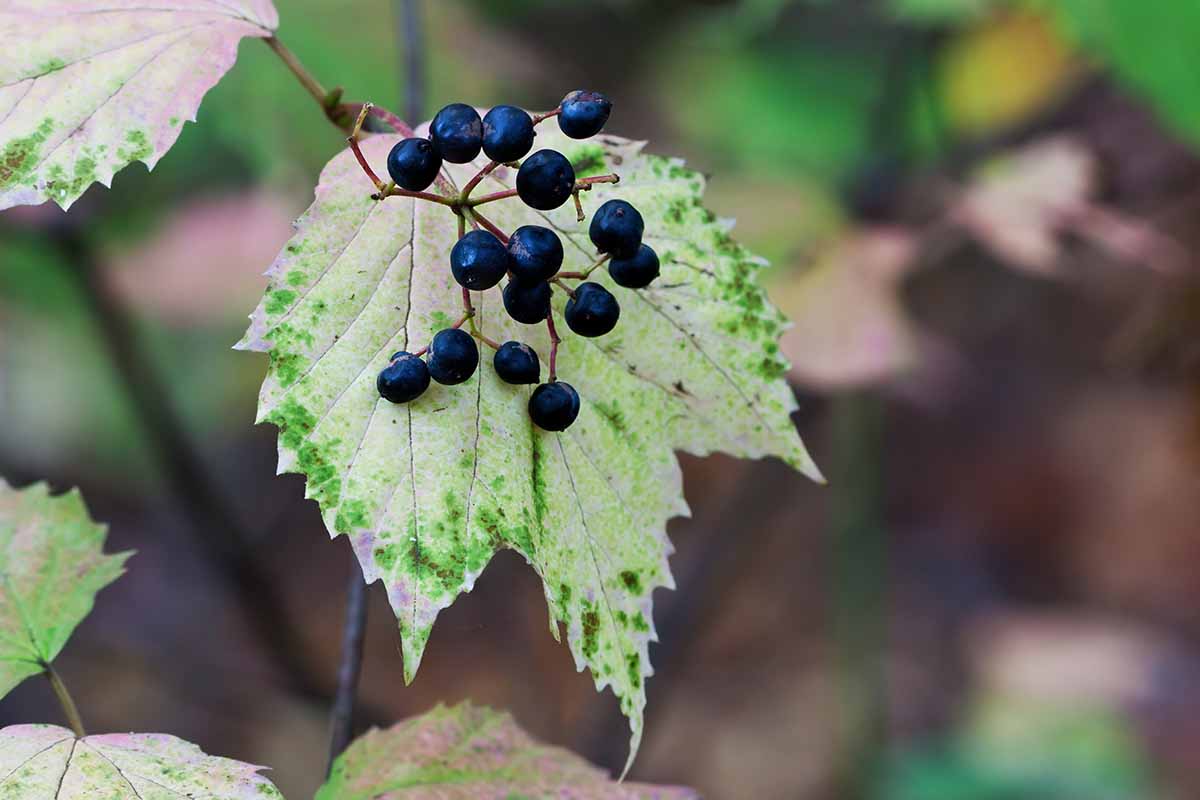
The species lives up to its name with mapleleaf-shaped foliage that shades to burgundy in the fall. Coupled with deep blue berries, it is an end-of-season spectacle.
This species is tolerant of deep shade and dry soil.
19. Mohican
V. lantana ‘Mohican’ is best known for having a spectacular month-long display of orange-red drupes that appear in midsummer.
This cultivar boasts flat-topped clusters of creamy white blossoms with yellow anthers. It is well-suited to Zones 4 to 8.
Mature heights are between six and eight feet. Widths may range from six to 10 feet.
‘Mohican’ is available from Nature Hills Nursery.
20. Nannyberry
Appreciated for its long-lasting blue-black autumn berries, nannyberry, V. lentago, grows in Zones 2 to 8.
Like the blackhaw, nannyberry grows as either a shrub or small tree. Shrubs are typically 14 to 16 feet tall and six to 12 feet wide at maturity. Small trees may reach 30 feet.
The flowers are white with prominent anthers. Autumn leaves are multi-hued with red berries that deepen to blue-black.
You can find two- to three-foot bare roots available at Nature Hills Nursery.
21. Onondaga
V. sargentii ‘Onondaga’ is suited to Zones 4 to 7. Maroon-tinged foliage emerges in the spring and gradually shades to green.
The eye-catching flowers resemble those of a lacecap hydrangea, with a ring of white blooms surrounding a center of maroon buds.
Red drupes complement the red autumn foliage.
Expect a mature height and width of six to eight feet. This cultivar prefers full sun.
‘Onondaga’ is available from Nature Hills Nursery.
22. Raspberry Tart
Raspberry Tart™, aka V. dentatum ‘Rastzam’ is so-named for having raspberry red fall foliage. It is a cultivated variety of native arrowwood viburnum that is suited to Zones 3 to 9.
Spring and summer foliage is glossy green. Flat-top clusters of white blossoms grace the tips of the branches in spring, and blue-black drupes follow at season’s end.
Mature dimensions are a modest four to five feet tall and wide.
This cultivar tolerates drought, salt, and wet soil.
Raspberry Tart™ is available from Nature Hills.
23. Shasta
V. plicatum f. tomentosum ‘Shasta,’ a double-file viburnum cultivar, grows in Zones 5 to 8.
It has flattened lacecap blooms lining the tiered horizontal branches for a rich, layered look.
The blossoms are white. Green foliage may shade to deep reds and purples as summer shifts to fall. Red berries ripen to black.
Mature dimensions are six to eight feet tall and eight to 12 feet wide.
Note that this species is considered invasive in Pennsylvania.
‘Shasta’ double-file is available from Perfect Plants Nursery and from Nature Hills.
24. Summer Magic
V. prunifolium ‘Summer Magic’ is a cultivated variety of blackhaw viburnum for Zones 4 to 9. It has exceptional foliage. The leaves start out pink and deepen to red and then green as they mature.
Blackhaw is a native species with an irregular shape cultivated as multi-branched shrubs or small trees.
Shrub heights are 12 to 15 feet tall and ten to 12 feet wide. Small trees may reach 30 feet.
The flowers are white. The leaves turn red and yellow in the fall and drupe production is minimal.
‘Summer Magic’ blackhaw is available from Nature Hills in #3 containers.
25. Wabi-Sabi
Wabi-Sabi®, V. plicatum var. tomentosum ‘SMNVPTFD,’ is a double-file cultivar suited to Zones 5 to 8.
It is a distinctly different type of viburnum. The blossoms are like a lacecap, but with large and small white flowers scattered randomly, for a playful, informal look.
Shrubs achieve a mature height of two to three feet and a width of three to four feet, making them appropriate for container gardening.
The foliage is evergreen in warmer regions and shades to reds and purples in cooler climes. Bright red berries top off this winner.
Wabi-Sabi® is available from Nature Hills.
Cottage Garden Charm
With 25 types of viburnum from which to choose, it’s time to get out the garden planner and choose one or more full sun to part shade locations for displaying your new favorites.

Use your new woody shrubs to create a delightful garden scheme with flouncy blooms and lush greenery.
Add fragrant species and cultivars for a sweet/spicy aroma, and snow-white flowering types that glow dreamily beneath the moonlight.
Choose flora with similar cultural requirements to accompany your viburnum, including:
- Azalea
- Beautyberry
- Camellia
- Creeping Phlox
- Hosta
- Hydrangea
- Witch Hazel
Viburnums make exceptional stand-alone specimens, informal hedges, and cottage garden companions.
Do you grow viburnum? Tell us about your favorites in the comments section below.
If you enjoyed this roundup and would like to learn more about growing viburnum, we recommend the following guides next:

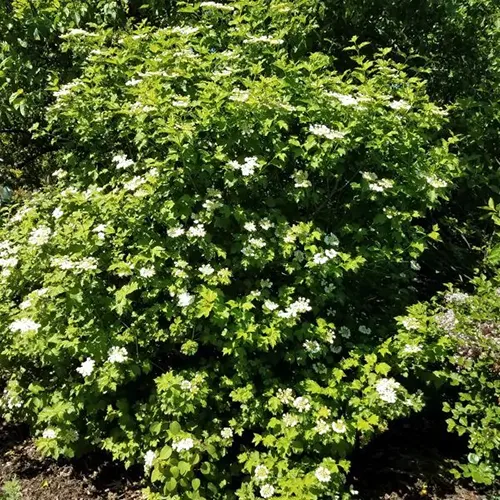
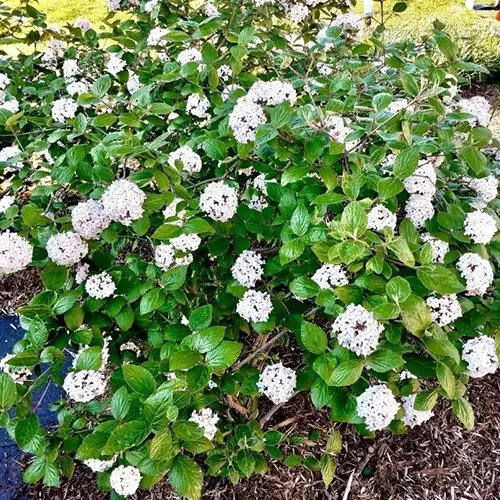
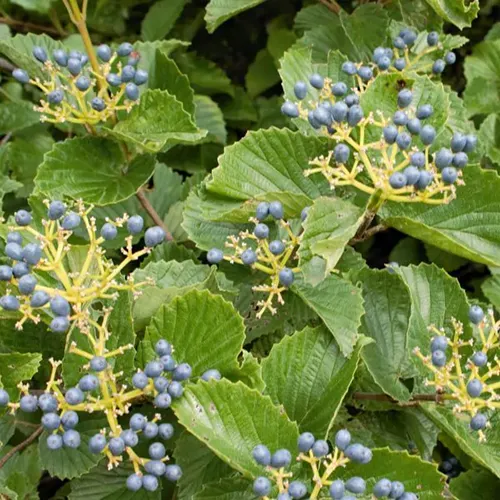
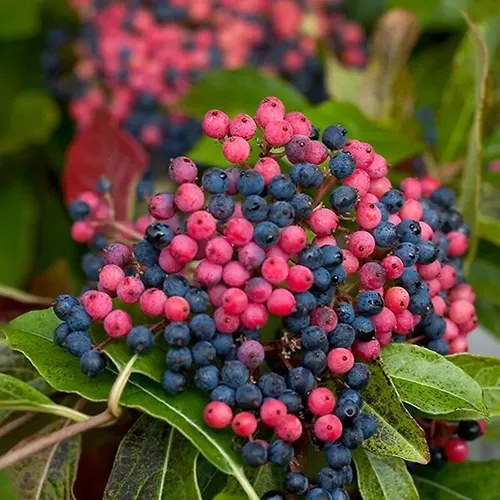
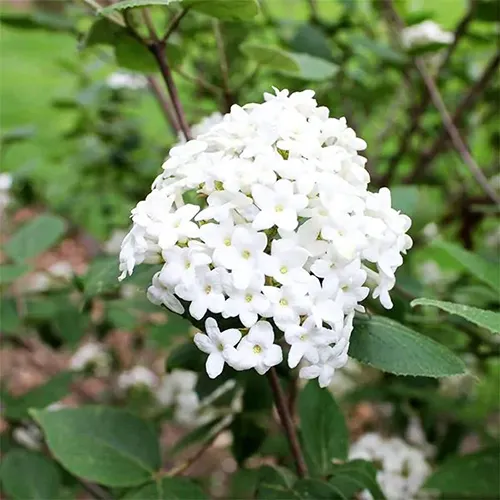
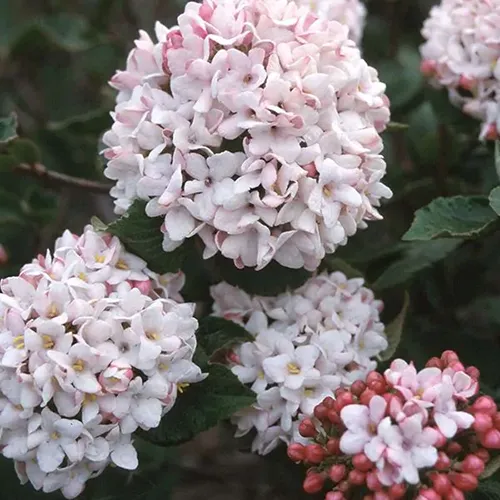
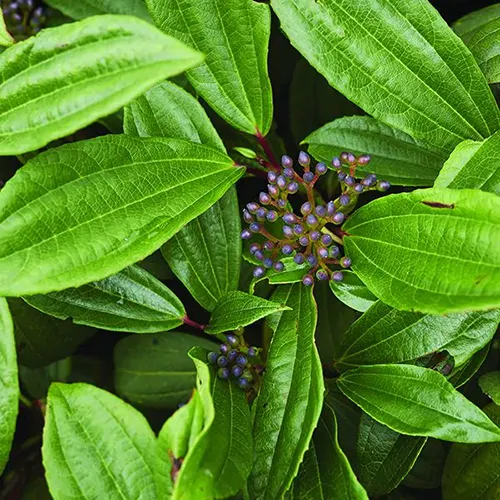

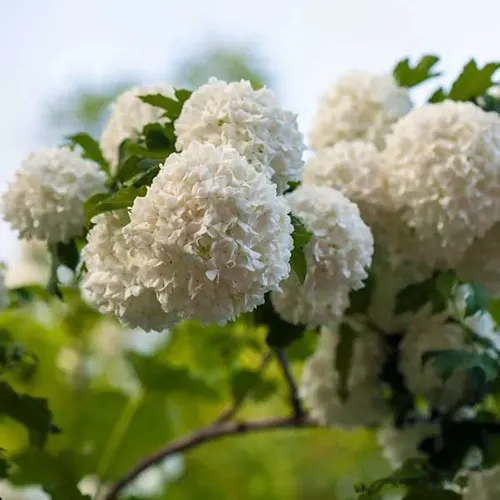
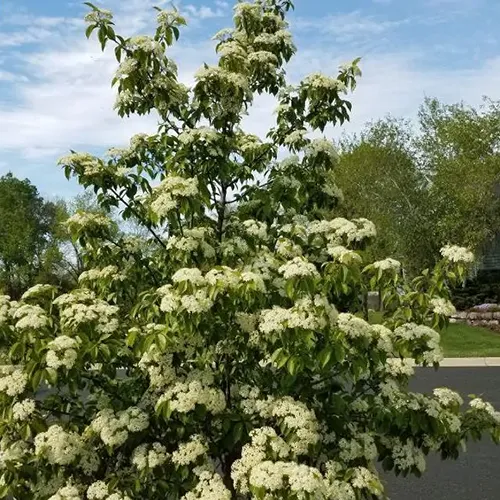
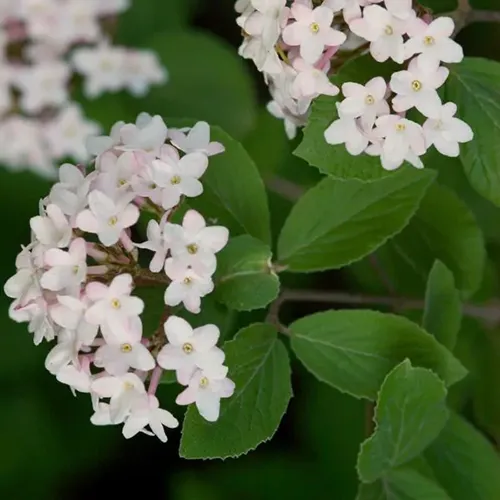
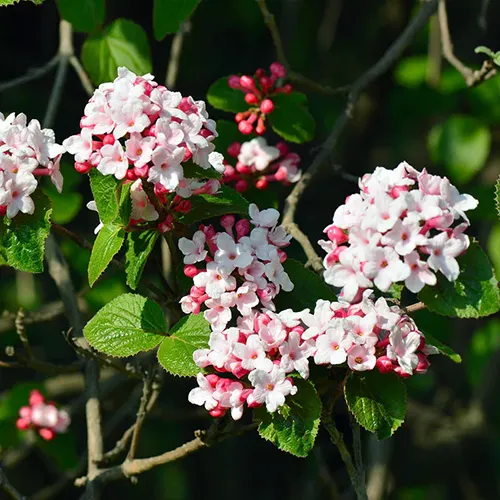
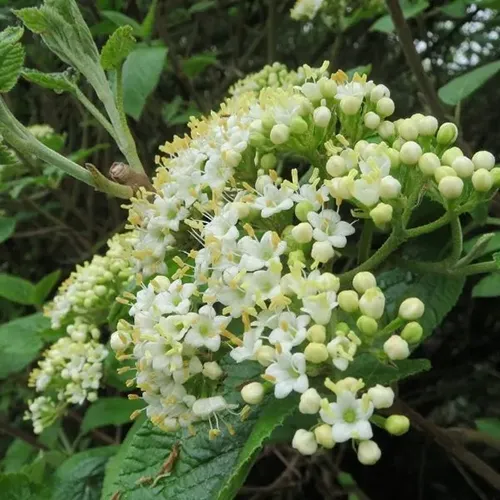
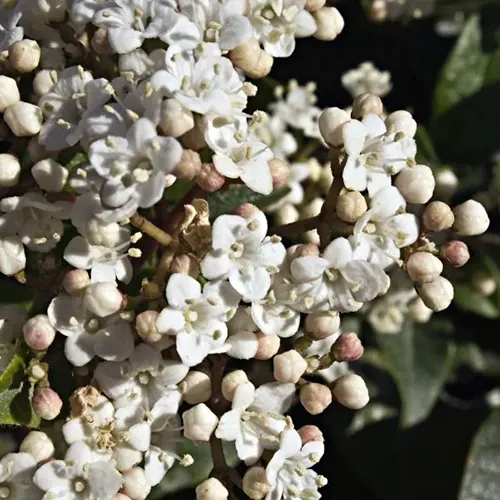



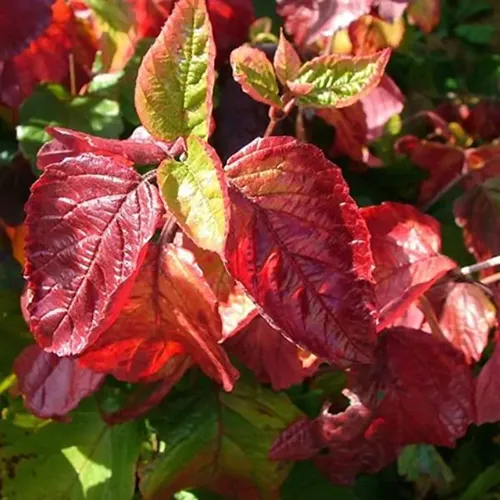
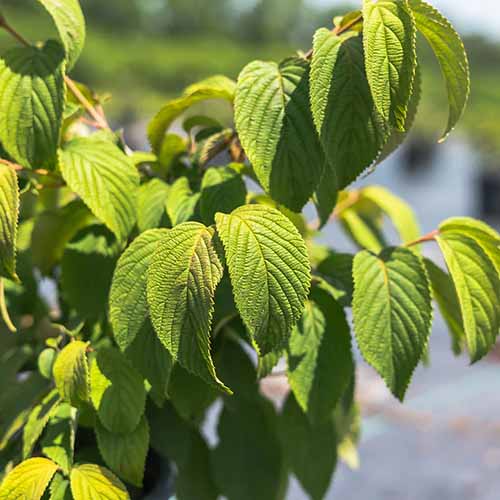
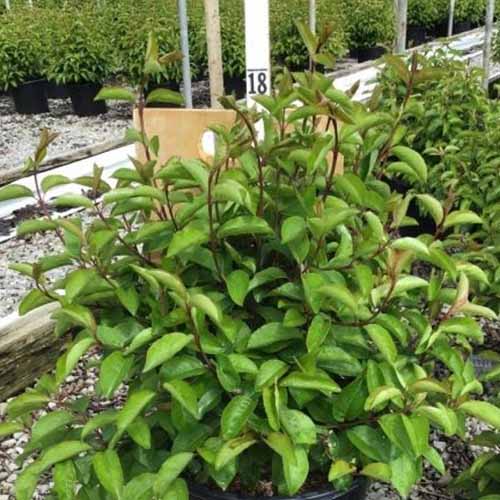
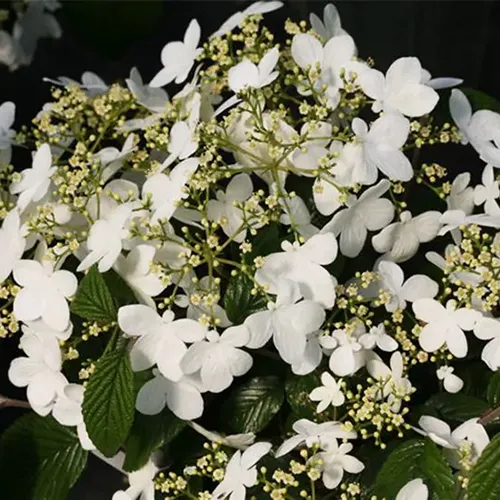
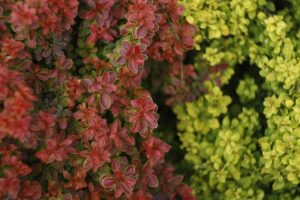


I need a light green snowball variety.
Hello Mary Ellen –
The Chinese snowball viburnum, Viburnum macrocephalum, is suited to Zones 6 to 9. It reaches mature dimensions of 25 feet tall and 20 feet wide under ideal conditions. The emergent blossoms are chartreuse shading to white.